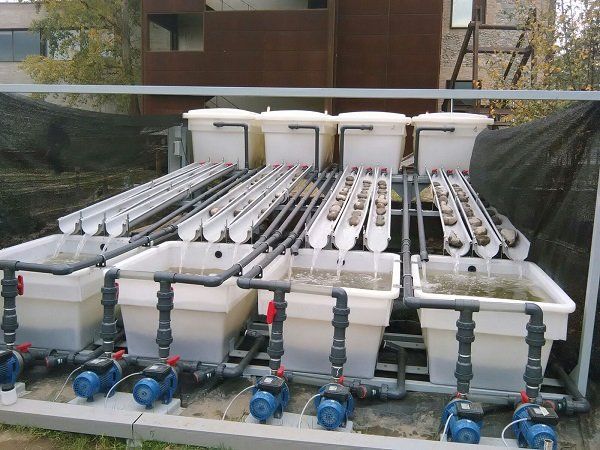
23
de Desembre
de
2016 - 09:30
There are a lot of cases of related groups that are not used to commincating. One prototypical case is that of universities and companies, which do not always take advantage of all the synergies they could establish. We can also find more specific examples, such as ecologists and engineers. The latter, for example, design water treatment plants, while the former analyse how treated water affects the biodiversity of the rivers in which it ends up. "It is good to have more communication between both parties, it helps to do the treatment in a more integral manner," Miguel Cañedo tells VIA Empresa, an ecologist who for the past two years has worked shoulder to shoulder with the engineers of BETA, a technological centre of Vic University. They do so via the TECNIOspring programme, which fosters the hiring of researchers in companies and technological centres.
Miguel came to Vic University as an associate professor after finishing a scholarship in the United States. "At BETA I was told about the possibility of applying TECNIOspring. To be able to unite ecology and engineering seemed interesting to me," he says. In his case, the work focused on a very specific form of pollution, salinization, in the area of Sallent, Súria and Cardona, where it is a serious problem because of the potash mining there. "We looked at how we could solve the problem in a more integral way."
An opportunity
Miguel Cañedo's case is only one example of the results offered by the possibility of moving research projects into technological centres. The Generalitat government, through the Acció agency, has just renewed a 10-million-euro project jointly funded by the European Commission so that senior researchers can develop applied research projects for two years. TECNIOspring , whose application period is open until February, for the first time includes the companies that host these researchers, rather than just the technological centres of the Tecnio network.
"Without Tecniospring I would never have done the project because I do not normally work with engineers," says Cañedo, who highlights the clear objective of obtaining "results with a direct application that can generate synergies with companies and have a commercial oultet." At the same time, he adds, "it promotes interdisciplinary work, through which you can learn a lot of new things. The Tecnio centres are very technological and the programme includes people of different profiles."
Moreover, Miguel's project has also allowed him to build an artificial river plant in Manlleu where tests on saline contamination can be carried out. "Halfway through the project the second-most important company in potash extraction contacted me, as they were interested in what I was doing," he recalls. It was an opportunity that had not been contemplated when the project was defined, but which allowed him to carry it out without any inconvenience. "It is very flexible because you can innovate and adapt to the demands of the company," he says.
Looking abroad
Cañedo has completed TECNIOspring's Entrance module, which includes a two-year stay in a company or Tecnio centre. However, now he is looking to go back and do the Leave Return module, which consists of a year abroad in a technological centre or the R&D department of a company, with a second year in Catalonia. "I would like to go to Swansea (Wales) with a group of engineers," he points out.
For the Industry director general, Núria Betriu, the programme's objectives are "to attract highly-talented researchers, both domestic and international," as well as "making an impact on the R&D activities of Catalan companies and centres." The researchers get a grant of between €55,800 and €68,100 a year, depending on the module of the programme they do.
In the case of researchers who want to apply to join a technological centre for two years, Cañedo recommends "doing research at the Tecnio centre that interests you the most, contacting them and talking to the centre's director about the idea behind your project." In this way, he insists, "you can better adapt your project proposal to what they do."
Miguel came to Vic University as an associate professor after finishing a scholarship in the United States. "At BETA I was told about the possibility of applying TECNIOspring. To be able to unite ecology and engineering seemed interesting to me," he says. In his case, the work focused on a very specific form of pollution, salinization, in the area of Sallent, Súria and Cardona, where it is a serious problem because of the potash mining there. "We looked at how we could solve the problem in a more integral way."
An opportunity
Miguel Cañedo's case is only one example of the results offered by the possibility of moving research projects into technological centres. The Generalitat government, through the Acció agency, has just renewed a 10-million-euro project jointly funded by the European Commission so that senior researchers can develop applied research projects for two years. TECNIOspring , whose application period is open until February, for the first time includes the companies that host these researchers, rather than just the technological centres of the Tecnio network.
"Without Tecniospring I would never have done the project because I do not normally work with engineers," says Cañedo, who highlights the clear objective of obtaining "results with a direct application that can generate synergies with companies and have a commercial oultet." At the same time, he adds, "it promotes interdisciplinary work, through which you can learn a lot of new things. The Tecnio centres are very technological and the programme includes people of different profiles."
Moreover, Miguel's project has also allowed him to build an artificial river plant in Manlleu where tests on saline contamination can be carried out. "Halfway through the project the second-most important company in potash extraction contacted me, as they were interested in what I was doing," he recalls. It was an opportunity that had not been contemplated when the project was defined, but which allowed him to carry it out without any inconvenience. "It is very flexible because you can innovate and adapt to the demands of the company," he says.
 |
| The artificial river plant installed in Manlleu | Ceded |
Looking abroad
Cañedo has completed TECNIOspring's Entrance module, which includes a two-year stay in a company or Tecnio centre. However, now he is looking to go back and do the Leave Return module, which consists of a year abroad in a technological centre or the R&D department of a company, with a second year in Catalonia. "I would like to go to Swansea (Wales) with a group of engineers," he points out.
For the Industry director general, Núria Betriu, the programme's objectives are "to attract highly-talented researchers, both domestic and international," as well as "making an impact on the R&D activities of Catalan companies and centres." The researchers get a grant of between €55,800 and €68,100 a year, depending on the module of the programme they do.
In the case of researchers who want to apply to join a technological centre for two years, Cañedo recommends "doing research at the Tecnio centre that interests you the most, contacting them and talking to the centre's director about the idea behind your project." In this way, he insists, "you can better adapt your project proposal to what they do."